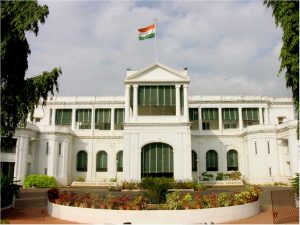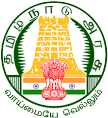
The earliest official residence of the Governors of Madras was in Fort St. George, the first one built in the 1640s. This was pulled down in 1693 and a new one was constructed eastward where, in later years, it became the core of the Secretariat. When the Governor’s ‘garden house’, near the erstwhile location of Government Law College, was destroyed by the French in 1746, a new garden house was acquired for the Governor after the French withdrawal in 1749 which came to be known as Government Estate. It was in the 1820s that Governor Thomas Munro (1820-27) made Government House the official residence and what has now grown into Raj Bhavan and was once Guindy Lodge, the Governor’s country house.
Guindy Lodge, it is believed, was built by Governor William Langhorne (1672-78) in the early 1670s. When Langhorne left in 1678, he sold the property to the then Chief Merchant of Madras, Chinna Venkatadri. When Chinna Venkatadri had problems with the East India Company, he gifted Guindy Lodge to the Company’s Madras Government.
Used as a Government ‘country house’ till the area was ravaged by the French and Mysore in the 18th century, Guindy lodge then passed into private hands at the beginning of the 19th century. The first private owner mentioned is Mr. Gilbert Ricketts of Madras, who in 1813, was seeking a loan from the Government bank. When Ricketts died intestate in December 1817, with the property heavily mortgaged to the Bank and one Mr. Griffiths, the estate devolved to the Registrar of the Supreme Court as Administrator. Protracted legal proceedings favoured the Bank which, in 1821, offered the property to the Government for a sum of 10,000 pagodas (or Rs.35,000). The government also acquired a nearby property for Rs.8,750 from the Armenian merchant Joseph Nazar Shawmier. Between 1821 and 1824, the Government-linked the two properties with a third purchaser, and the Raj Bhavan property as it existed during Independence came into being.
Governor Sir Thomas Munro was responsible for the purchase of Guindy Lodge, and the expansion of its estate. He pointed out the necessity of a country house for the Governor “where he could transact public business uninterruptedly”, as his residence in the Fort was at the time being relinquished for the construction of the Secretariat.
When Guindy Lodge became the official country residence of the Governor, there were three single-storeyed bungalows in existence on the site of the present building. Between 1837 and 1841, various alterations and improvements were carried out by Lord Elphinstone, whose pet project was to develop Guindy Lodge into something like what it is today. He also developed what is now called Taluk Office Road as a grand drive up to the house from Mount Road (now Anna Salai). Governors – The marquis of Tweeddale, Sir Henry Pottinger, Lord Harris, and Sir William Denison made further improvements and by 1863 the Lodge had acquired its present shape. Lord Erskine was responsible for the addition of the wings in 1937 which buttressed three corners of the Main Block.

After independence large areas of land adjoining Raj Bhavan were made over for other public purposes. Sharing space with Raj Bhavan is the Indian Institute of Technology, Madras whose 388-acre campus was carved out of the Park in 1958, and forms the eastern boundary of Raj Bhavan estate. The Guindy Children’s Park, the Snake Park, various memorials for political leaders, and the Cancer Institute take up small portions of the park on the north. The land was transferred for the Mahatma Gandhi memorial in 1954, in 1974 for the Rajaji Memorial, and in 1975 for the Kamaraj Memorial. In 1958, nearly 625 acres were transferred to the Tamil Nadu Forest Department for a Park and in 1977, nearly 88 more acres were given to the Forest Department for the National Park that was intended.
Today, the Governor’s residential compound is fenced off from the rest of the buildings in the vicinity. The compound consists of the Governor’s mansion, besides the Presidential Block and the Bharathiar Mandapam which are recent additions. A large well-manicured lawn to the south where ‘At Home’ and other State functions are held, ornamental gardens to the east and the north, and horticultural and herbal gardens to the west and north give the residence a verdant setting. Raj Bhavan is also the home to a few other historic buildings and residences. The White House, The Cottage, The Nook, The Governor’s Secretariat, and the Governor’s Household Office are historical buildings that have been renovated for contemporary use. Raj Bhavan is also home to rare species of flora and fauna including the blackbuck.
Raj Bhavan as it stands today is an assemblage of various additions and modifications that have happened over a long history.

